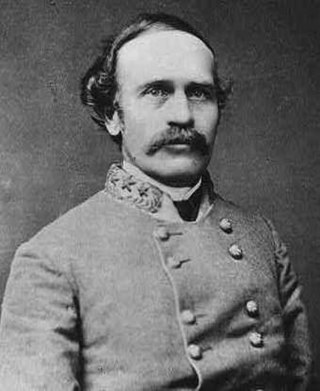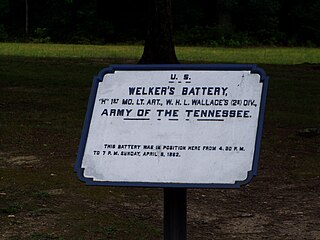1862 (MDCCCLXII) was a common year starting on Wednesday of the Gregorian calendar and a common year starting on Monday of the Julian calendar, the 1862nd year of the Common Era (CE) and Anno Domini (AD) designations, the 862nd year of the 2nd millennium, the 62nd year of the 19th century, and the 3rd year of the 1860s decade. As of the start of 1862, the Gregorian calendar was 12 days ahead of the Julian calendar, which remained in localized use until 1923.

Fort Donelson was a fortress built early in 1862 by the Confederacy during the American Civil War to control the Cumberland River, which led to the heart of Tennessee, and thereby the Confederacy. The fort was named after Confederate general Daniel S. Donelson.

The Battle of Fort Henry was fought on February 6, 1862, in Stewart County, Tennessee, during the American Civil War. It was the first important victory for the Union and Brig. Gen. Ulysses S. Grant in the Western Theater.

The Battle of Fort Donelson was fought from February 11–16, 1862, in the Western Theater of the American Civil War. The Union capture of the Confederate fort near the Tennessee–Kentucky border opened the Cumberland River, an important avenue for the invasion of the South. The Union's success also elevated Brig. Gen. Ulysses S. Grant from an obscure and largely unproven leader to the rank of major general, and earned him the nickname of "Unconditional Surrender" Grant.

The Army of the Tennessee was a Union army in the Western Theater of the American Civil War, named for the Tennessee River.

Bushrod Rust Johnson was a Confederate general in the American Civil War and an officer in the United States Army. As a university professor he had been active in the state militias of Kentucky and Tennessee and on the outbreak of hostilities he sided with the South, despite having been born in the North in a family of abolitionist quakers. As a divisional commander he managed to evade capture at the Battle of Fort Donelson, but was wounded at the Battle of Shiloh. He served under Robert E. Lee throughout the 10-month Siege of Petersburg, and surrendered with him at Appomattox.

USS Baron DeKalb was a City-class ironclad gunboat constructed for the Union Navy by James B. Eads during the American Civil War.
Brackett's Minnesota Cavalry Battalion was a Minnesota USV cavalry battalion that served in the Union Army during the American Civil War.

Samuel Gibbs French was an American military officer from New Jersey. He graduated from the United States Military Academy in 1843, served as a captain in the U.S. Army in the Mexican-American War, and was wounded at the Battle of Buena Vista. In 1856, he resigned his commission to manage a plantation in Mississippi he obtained through marriage.
The 22nd Indiana Volunteer Infantry Regiment was an infantry regiment that served in the Union Army during the American Civil War. On October 8, 1862, at the Battle of Perryville, Kentucky, the regiment suffered 65.3% casualties, one of the highest percentages of casualties suffered by any American Civil War regiment in a single engagement.
The following outline is provided as an overview of and topical guide to the American Civil War:
Siege of Fort Henry may refer to:
Events from the year 1862 in the United States.
The 22nd Ohio Infantry Regiment, originally mustered in as the 13th Missouri Infantry Regiment, was an infantry regiment in the Union Army during the American Civil War.
The 47th Regiment Indiana Infantry was an infantry regiment that served in the Union Army during the American Civil War.
3rd Indiana Battery Light Artillery was an artillery battery that served in the Union Army during the American Civil War.
89th Indiana Infantry Regiment was an infantry regiment that served in the Union Army in the Western Theater of the American Civil War.

Landis's Missouri Battery, also known as Landis's Company, Missouri Light Artillery, was an artillery battery that served in the Confederate States Army during the early stages of the American Civil War. The battery was formed when Captain John C. Landis recruited men from the Missouri State Guard in late 1861 and early 1862. The battery fielded two 12-pounder Napoleon field guns and two 24-pounder howitzers for much of its existence, and had a highest reported numerical strength of 62 men. After initially serving in the Trans-Mississippi Theater, where it may have fought in the Battle of Pea Ridge, the unit was transferred east of the Mississippi River. The battery saw limited action in 1862 at the Battle of Iuka and at the Second Battle of Corinth.
The 4th Missouri Infantry Regiment was formed on April 28, 1862, and served in the Confederate States Army during the American Civil War. The infantry regiment did not see action at the Battle of Farmington on May 9, and the Battle of Iuka on September 19 despite being part of the Confederate force present at those battles. As part of Brigadier General Martin E. Green's brigade, the regiment participated in three charges against Union lines on October 3, 1862, during the Second Battle of Corinth. The following day, the regiment, along with the rest of Green's brigade, attacked the new Union lines. Despite initial success, the attack was repulsed by a Union counterattack. The regiment ceased to exist as a separate unit when it was combined with the 1st Missouri Infantry Regiment on November 7, 1862, to form the 1st and 4th Missouri Infantry Regiment (Consolidated).

Battery H, 1st Missouri Light Artillery Regiment was an artillery battery unit from Missouri that served in the Union Army during the American Civil War. The 1st Missouri Light Artillery Regiment was created on 1 September 1861. Battery H fought at Fort Henry, Fort Donelson, Shiloh, 1st Corinth, and 2nd Corinth in 1862. The battery performed mostly garrison duty in 1863. The unit was in action in the Atlanta campaign and Sherman's March to the Sea in 1864 and in the Carolinas campaign in 1865. Battery H marched in the Grand Review of the Armies before being mustered out on 16 June 1865.








